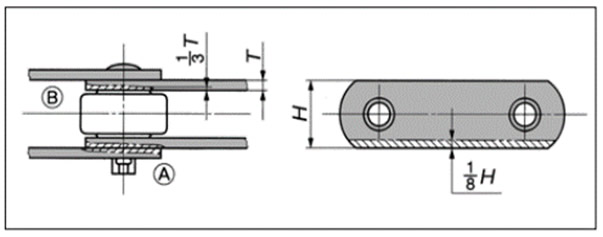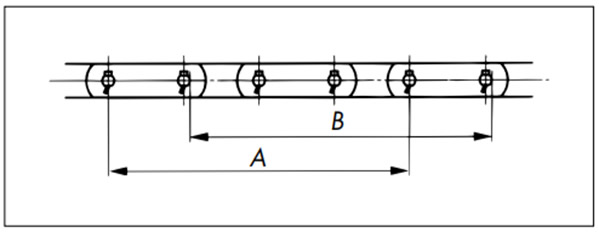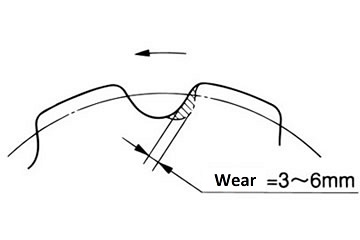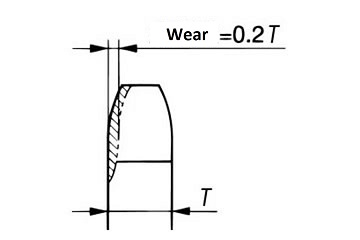Technical Data Large size conveyor chain Handling
7. Limits of Conveyor Chain Use
As usage limits for each component of the conveyor chain are noted below, check the degree of wear of each component on a regular basis.
These usage limits are values determined based on the performance of the conveyor chain itself. If there is a usage limit for the conveyor body, use this as the base value.
Replace the chain and sprockets at the same time.
7.1 Part Usage Limit
7.1.1 R-roller ・F-roller
Plate has reached its limit when bottom of a plate begins to touch a rail due to wear on contact surface or sliding area with a bush.
R and F roller limits

If there is a curve in the rail then there will be less wear allowance for the corresponding S dimension only as per the figure below. Special care is needed compared to flat conveyance.
Less wear allowance

7.1.2 S, M, N-roller
When roller thickness wears to 40%.
7.1.3 Bush
When bush thickness wears to 40%.
7.1.4 C-Pins
When wear has reduced the pin diameter to 85% of original value (cannot be visually inspected).
7.1.5 Measuring Plate Thickness or Height Wear
Wear will develop from abrasion between plates and roller and plate contact at (A) and (B) below.
Chain strength will be insufficient when wear exceeds 1/3 of the plate's normal thickness.
If items are conveyed directly on the plate as with flow conveyors, or if they slide on top of steel plates, then chain life will have been reached when plate height is worn by 1/8 as per the figure below (right).
Plate wear

7.1.6 Chain Wear Elongation
A chain articulates when it engages the sprocket or along the curved portion of a rail, at which time a chain will elongate due to sliding wear between the bush and pin.
The chain elongation limit is 2% (2mm of elongation on one link if pitch is 100mm) of a standard basic length (pitch × no. of links).
- 1) Measuring chain length

Measure as many links as possible (at least four links) as per the figure above.
Measure from: (A) center of pin to center of pin, or (B) end of pin to end of pin
(A)Center of pin to center of pin
(B)End of pin to end of pin
- 2) Chain elongation (%)
Measure chain using one of the above methods, compare to standard length, and determine chain elongation (%).
Chain Elongation = Measuring dimension - Standard length Standard length × 100(%)
7.1.7 Wear on Sprocket Teeth Face or Sides
Worn sprocket teeth may accelerate chain wear during engagement.
Regularly inspect both sprockets and chains.
- 1) Wear limits for sprocket teeth surfaces are roughly shown in the figure below.
Tooth surface wear

Tooth side surface wear

- 2) Tsubaki recommends replacing the sprocket when teeth are worn. Avoid flipping the sprocket over and continuing to use sprockets with worn teeth bottoms.

